Apendix VII
Small Ships Section
Soon after the Brigade's arrival in New Guinea it became apparent that some type of supply vessels were needed as the Brigade was being spread further and further as the result of the landings at Tambu Bay, Lae, and Finschhafen. All supplies, including vital boat spare parts, were located at Oro Bay and the units needing them were a hundred or more miles away; hence, difficult to supply by our landing craft. As more landings would be made the greater would be the need for supply vessels.
It was not until April 15, 1944, when the F-15 was assigned to the Brigade, that the small ships section came into being. This was supplemented by the tug ST-381 joining on August 5, 1944, ST-18 on August 29, 1944, and FS-175 on October 4, 1944. The F-15 and US-175 were cargo boats of 65 and 200 tons cargo capacity respectively. The ST-18 and ST-381 were 75-foot tugs and needed to tow the six fuel barges assigned to the Brigade.
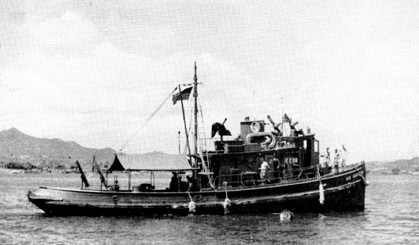
ST1 - 381 -- 72’ Wood tug - 91 tons. Speed 8 knots.
Towing ability 300 tons at 5 knots. Cruising range 3000 miles.
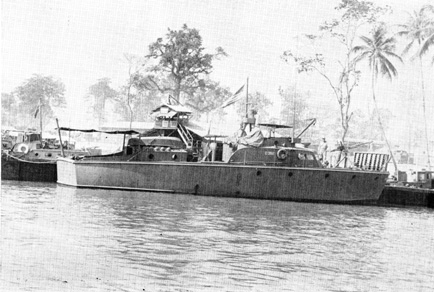
INVADER -- 63’. Crash boat -- General Heavey’s Command Boat.
Speed 24 knots.
The F-15, commanded by 1st Lt. Edwin T. poster of the 532d EBSR, was immediately put to work carrying critical boat spare parts and supplies from Oro Bay to Biak, making one trip right after the other and, occasionally, going to the Admiralty Islands. On the Leyte show she towed three crash boats, besides carrying a full load of cargo and bad the distinction of being the first F Boat to arrive at the far shore. The crew was justifiably proud. The F-15 not only shot Jap planes down but also brought them in to prove it. On this occasion they shot down a Jap floatplane in 12 feet of water, so they hooked the boom on it and brought it in. It was a new type of plane never before encountered and Lt. Foster and crew were commended by Lt. Gen. Walter Krueger, Commanding General, 6th Army.
The ST-381 came to the brigade - with a civilian ATS crew,, which was replaced by an all Brigade crew with S/Sgt. (now 2d Lt) Benjamin H. Sooy, Jr. of Atlantic City, New Jersey in command with the following men comprising the crew: T/4 M. C. Papenfuss, TS/5 FrankLin K. Flower, Thomas Woienski, Privates W. C. Driscoll, Henry Keeney, G. H. Hultburg, W. S. Weisner, H. W. Clark, and Verner Smith.
The crew of this boat had its share of thrills. While entering Leyte Gulf with a loaded fuel barge in tow from Hollandia, they encountered numerous Jap planes, which were a put of a great Jap carrier force. Fortunately, they were not attacked. It was not long until the ST-381 drew blood by downing a Jap "Betty" bomber. As a result, a small Jap flag was painted on its stack and this flag was soon followed by two more. On the return trip from the invasion of Mindoro a typhoon was encountered but the ST 381 rode it out. It was a rugged ride as several members of the crew had cause to remember.
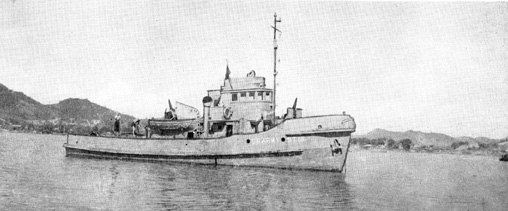
ST - 18 --- 75’ Steel tug-92 tons. Speed 9 knots.
Towing ability 300 tons at 6 knots. Cruising range 4500 miles.
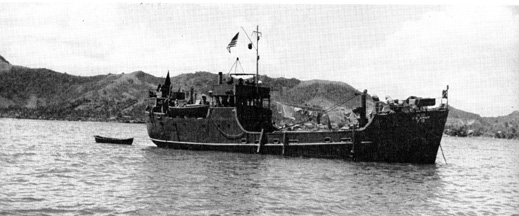
F-15 --- 99’ Freighter. 168 tons. Speed 7 knots. Cruising range 3700 miles.
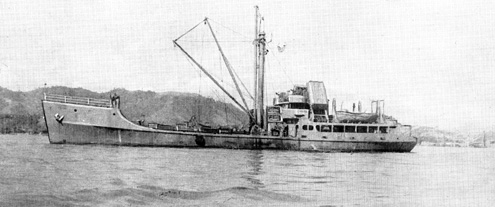
FS - 175 --- 180’ Freighter. 470 tons. Speed 11 knots.
Cruising range 8000 miles
The ST-18 was commanded by a civilian skipper, John B. Barber, who had the following 2 ESB personnel for a crew: TS/4 Frank Rainos, Timothy Murphy, Ts/5 William P. Dehaut, William C. Morrison, Evans B. Ratcliffe, Pfc. Richard A. Busch, and Pvt. Albert Browneski.
While enroute to Ormoc on the West Coast of Leyte with a full fuel barge in tow, the ST is shot down a Jap plane entitling her to one Jap flag on the bridge. She claims the record for the longest tow across open sea, 2300 miles from New Guinea to Leyte and she was the first vessel, other than the Brigade's assault landing craft, to enter Orinoc Bay. All during the Philippine campaign she has been busy towing barges from island to island, often without naval escort.
The FS-175 was crewed by the Coast Guard and it fitted in well with the other craft. It was the workhorse of the fleet as it carried three times as much cargo as did the F-15. She was commanded by Lt (JG) H. W. Mueller. Since joining the Brigade the FS-175 has carried cargo from New Guinea, Biak, and the Admiralty Islands to all the major islands of the Philippine Islands helping to keep the forward units supplied with necessary boat spare parts and other vitally needed supplies.
Early in January, 1945, it was found necessary to put an officer in charge of the special craft to assist them in getting supplies, fuel, water, and repairs. Captain M. 0. Spelts Jr of Lincoln, Nebraska, was selected for this job. He was kept busy arguing with the Navy for dry dock space and with Transportation Corps for parts and repair crews. The fact that he was later awarded the Bronze Star Medal attests to his efficient work.
The Invader, General Heavey's Crash Boat, was commanded by 2d Lt Malcolm H. Phillips of Rockport, Maine, with the following men comprising the crew: T/4 Joseph W.Lynch, T/5 Harvey J. Campbell, Jr., and Privates First Class Donaly W. Myers, and Charles S. McKinney.
This boat was used by the General in trip to the forward areas where he was on inspection trips and on occasion, a little fishing was done. The General caught a 45-pound King Mackerel and it fed all the men of the operational headquarters at a time when the food wasn't too good.
The Invader was used several times to run urgently needed spare parts to the forward areas. She also, on one occasion, went to the rescue of some downed airmen and was successful.
Report by 2 ESB Tug
S.T. 381
APO 72
21 December 1944.
General William F. Heavey
Headquarters, 2nd ESB
APO 72
Using Cancabato Bay, 500 feet off the Tacloban Air Strip as our permanent mooring, we have found it to be a rather hot corner at times. You know of the numerous attempts to knock that strip out since our arrival here.
With all fairness to the other men who are in the same game and trying their best to bringthem down, I can say honestly that we gave one "Bogie" all that a single fifty could pump into him for a half a minutes
On November 17, approximately 17:00 hrs, as the day coverage was making their landings with running lights on, one of the Honorable Nips was making a sneak on it, to strafe the field, lights on, as though he was one of our planes. The searchlight on the point spotted him being so close and low that A-A. had little opportunity. Only a few shots were fired. This was our tip off and we gave it to him for at least 3/4 of the strip when he burst into flames and crashed on the west beach opposite the southern end of the strip. We were thankful when we found out later that we had not made a case of mistaken identity. This was our first plane.
Hunting being good and being informed we had a mission coming up, we applied strongly to the Brigade Ordnance Maintenance to give us more guns, and they complied. Before leaving on our mission we had five single fifties, two forward, two aft and one midship. Our ESB gunners were fit and ready for any Jap planes.
December 11, Monday, orders were to proceed to Dulag and rendezvous for the night. Tuesday, the 12th, 05:30 hrs. found us proceeding on orders from the Escort Commander to sea, destination unknown, towing a 2 ESB fuel barge full of distillate. There was no activity the first day out. We were swung into Cabalian Bay, in the lower Surigao Straits on account of some trouble which was not revealed to the ships of the convoy.
At 21:00 hrs, we made the Narrows entering Mindanao Sea. There was light A.A. from the tip of Mindanao, but we were under strict orders not to fire at night unless directly attacked. December 13th, at 15:00 hrs while in Lat. 9 degrees 19’ N, Long. 124 degrees 18' E. one long "Bogie" at high level, coming from the southeast, dove and missed the LCT in stern position of our column by 500 feet with two anti-personnel bombs. We all cut loose but he proved too elusive and flew off to Northward. We were sorry we didn't get him.
On Thursday the 14th, while in Lat. 9' 04' N, Long. 122' 28' E, at 08:00 hrs, two Japs were coming into the convoy's stern from a Northeasterly direction, and another was meeting us dead on. We were grateful as we spotted them to see a Navy Corsair on the tail of the lower one astern. He had winged him but the Nip tried to keep himself up after his dive to reach and crash one of our escort destroyers. He failed to reach his mark by 200 yards. Still having his bomb load with him, be caused a large explosion when he struck the water.
His partner above him, at high level, did not want any part of the Corsair or us. This was also the case of the one ahead of us who turned and fled, dropping his load of four bombs one mile ahead of the convoy.
Friday morning the 15th at 06:00 hrs. heavy A.A. was going up astern of us from a large convoy on the horizon. At 11:00 hrs: in Lat. 10' 38' N, Long, 121' 22' E, a twin engine Jap bomber dove at the convoy from the Northeast, leveled off and picked on the second column, the next to our right, just the way we wanted him, For we had three fifties to greet him and they emptied what they had into him. The after gun hit him for 15 seconds, knocking one of his bombs off.
The bomb missed the after barge in column 2. This was our second kill.
One of the escort destroyers was making the rear swing of his patrol and was very glad the Nip was not under control and crashed 300 feet off his starboard bow. The Commanding Officer and the crew of the DE acknowledged this by saying 'We were doing a splendid job', also by gesturing as grasping their hands in a warm hand shake.
Later in the afternoon out towing cable parted which was probably an act or an event in our favor, relative to events to follow on the next day. The cable was repaired and we were underway in 30 minutes but the Commander's orders changed us to the rear of column I, the tanker Y-14 taking up our old position.
Saturday, the 16th, started as a. quite and peaceful day. The sea had gone down and the southern end of Mindoro was in sight. Mindoro was our destination.
At 09:20 hrs. a bomber came in from the Northwest on our side of the convoy and leveled off low, leaving the destroyers in a hard position for their heavy guns to be effective. After he crossed the bow of the outside destroyer our two forward and midship guns kept pumping him. He attempted a left bank, but was out of control, trying to crash the Y-14 tanker, who was now in our former position of the convoy. He could only give her a glancing blow off the port quarter while in a vertical bank and dive. He crashed immediately after, rounding the tanker's stern. At least 5 or 6 of the tanker's crew jumped overboard and were picked up by the two LCTs of our convoy. I believe some of her crew were lost, as the Escort Commander asked all ships if they had picked up any men. The tanker proceeded under her own power.
We arrived and anchored our barge at 22:00 hrs., 400 yards off the beach of designated anchorage.
Sunday, the 17th, 02:00 hrs., Captain Harris, of the 532d Engr Boat & Shore Regt., contacted us with his Picket Boat. We moved the barge two miles North for him to have the barge under A.A. coverage.
The Escort Commander sent a destroyer in for us, at 04:00 hrs. for he had the convoy underway on it's return trip. By now the Navy was catering to its little "Mascot" and was seeing that we didn't get lost. That's the impression they gave us.
The convoy departed at 05:00 hrs. Sunday, the 17th. The return trip was uneventful, that is, nothing came close to us. The Navy opened up on two occasions but they were 3 to 5 miles away.
We encountered two days of rough weather having to ride in the trough of the sea. It seems as though little "Betsy" was trying to make her two "Victory Rolls" on both those days.
Sunday, December 17th at 18:00 hrs. the flags were half masted in the convoy for a burial at sea from the LST 605.
We moored in Cancabato Bay, 15:30 hrs., Tuesday the 19th.
Quite a long story for a 72 foot Tug of 4 Civilians and 6 GIs, of old 2 ESB.
Respectfully yours,
R. E. CARPENTER,
Master, ST 381, 2 ESB.
James Mahone-Chief Engineer
Grant Shanahan-1st Asst. Engr,
Pvt. H. Keeney-2nd Asst. Engr.
Alpha Moore-1st Mate
T/4 M.C. Papenfuss-2nd Mate
Pvt. G. H. Hultburg-A.B.
T/5 N. L. Dewar-A.B.
Pvt. H. N. Clarke-A.B.
Pvt. N. H. Weisner-Cook
T/5 T. J. Auriemma-Signalman
|